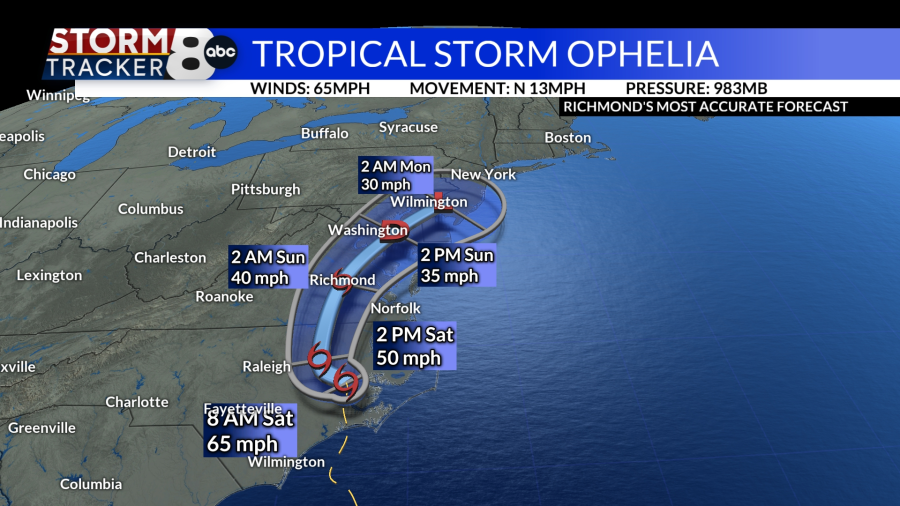
Ophelia’s Aftermath: NYC Braces for Potential 7-inch Rainfall and Severe Flooding on Friday

New York City is on high alert as it prepares for potentially devastating rainfall and severe flooding on Friday. The aftermath of Hurricane Ophelia has already brought torrential rain, causing flooding and disruptions across the city. With the National Weather Service warning of rainfall totals exceeding 8 inches in parts of the tri-state area, and millions of people under flash flood warnings, the situation is urgent. New York Governor Kathy Hochul has declared a state of emergency, urging residents to stay home due to dangerous travel conditions. The heavy rain is expected to continue throughout the day and into Saturday morning, with concerns of river and coastal flooding adding to the potential risks. This rainfall event could potentially rank among the top 5 for wettest Septembers on record in New York City, further highlighting the impact of climate change on heavy precipitation events in the Northeast.
Key Takeaways: OPHELIA
- New York City is bracing for severe flooding and a 7-inch rainfall on Friday due to the aftermath of Hurricane Ophelia.
- Torrential rain has already caused flooding, road closures, and disrupted subway service in the city.
- The National Weather Service warns of rainfall totals exceeding 8 inches in parts of the tri-state area, with millions of people under flash flood warnings.
- Governor Kathy Hochul has declared a state of emergency and urges residents to stay home for their safety.
- River and coastal flooding are major concerns as the heavy rain is expected to continue throughout the day and into Saturday morning.
- This rainfall event could potentially rank among the top 5 for wettest Septembers on record in New York City.
- Climate change has been linked to an increase in heavy precipitation events, and the Northeast has seen a significant rise in heavy rainfall in recent decades.
Current Situation and Impact of Torrential Rainfall
The torrential rain in NYC has already caused significant disruptions, including road closures, disrupted subway service, and overwhelmed basements. The city is grappling with the aftermath of Hurricane Ophelia, which has left its mark with relentless downpours. Transportation has been severely affected, with multiple road closures due to flooding and limited subway service. Residents are facing challenges as basements and lower levels of buildings become inundated with water.
The impact of the torrential rainfall is evident across the city. Roads that are typically busy with traffic have turned into virtual rivers, making travel treacherous and impassable. New York City’s subway system, a lifeline for commuters, has experienced delays and disruptions as water seeped into stations and tracks. The situation is further complicated by overwhelmed basements, where residents are struggling to mitigate and contain the flooding.
The National Weather Service has issued flash flood warnings for millions of people in the tri-state area, indicating the urgency and severity of the situation. With rainfall totals potentially exceeding 8 inches, the risk of flash flooding is high. New York Governor Kathy Hochul has declared a state of emergency, calling on residents to stay home to avoid dangerous travel conditions. The heavy rain is expected to persist throughout the day and into Saturday morning, prolonging the challenges faced by New Yorkers.
Quotes:
The torrential rain has turned streets into rivers and disrupted subway service, causing chaos for commuters.
List:
- Impassable roads due to flooding
- Disrupted subway service
- Overwhelmed basements and lower levels of buildings
Table:
| Impact Areas | Effects |
|---|---|
| Roads | Closures due to flooding |
| Subway | Delays and disruptions |
| Buildings | Basement flooding |
Weather Service Warning and Flash Flood Warnings
The National Weather Service has warned that rainfall totals exceeding 8 inches are increasingly likely in parts of the tri-state area, leading to flash flood warnings. The torrential rain has already caused flooding in New York City, resulting in road closures and disrupted subway service. Basements in many residential areas have also been overwhelmed by the heavy rainfall.
The severity of the situation has prompted New York Governor Kathy Hochul to declare a state of emergency and urge residents to stay home due to dangerous travel conditions. The heavy rain is expected to continue throughout the day and into Saturday morning, exacerbating the risk of flash flooding. River flooding and coastal flooding are additional major concerns, as the heavy rainfall continues to impact various areas of the city.
This rainfall event could potentially rank in the top 5 for wettest Septembers on record in New York City, highlighting the significance of the current weather conditions. Climate change has been linked to an increase in heavy precipitation events, and the Northeast region has experienced a notable surge in such weather occurrences in recent decades.
| Flood Warning | Flash Flood Warning | River Flood Warning |
|---|---|---|
| Issued when flooding is imminent or occurring | Issued when flash flooding is imminent or occurring | Issued when river flooding is imminent or occurring |
| Advises residents to take necessary precautions | Urges residents to seek higher ground immediately | Encourages residents in affected areas to move to higher ground |
It is crucial for residents to stay informed through reliable sources such as the National Weather Service and their local authorities. As preparations continue, securing personal belongings and ensuring the safety of oneself and loved ones should be the top priority. Stay vigilant, be prepared, and follow the guidance provided by emergency officials to minimize the potential risks associated with the heavy rainfall and flash flooding in New York City.
State of Emergency Declared by Governor Hochul
New York Governor Kathy Hochul has declared a state of emergency, urging residents to stay home and prioritize their safety due to dangerous travel conditions. The aftermath of Hurricane Ophelia has brought torrential rain to the city, causing severe flooding and widespread disruption. The governor’s declaration emphasizes the urgency of the situation and the need for residents to take necessary precautions.
Flash Flood Warnings and Travel Disruptions
The National Weather Service has issued flash flood warnings for millions of people in the tri-state area as rainfall totals continue to rise. With rainfall exceeding 7 inches, road closures, disrupted subway service, and overwhelmed basements have become common occurrences in New York City. The governor’s state of emergency aims to protect residents from these hazardous conditions and ensure their safety.
River and Coastal Flooding Concerns
In addition to the immediate impact on transportation and infrastructure, there are growing concerns about river and coastal flooding. As the heavy rain persists, the risk of rivers overflowing and coastal areas being inundated becomes greater. These additional sources of flooding pose further threats to residents and their properties.
| Impact of the Rainfall | Measures to Take |
|---|---|
| Severe flooding | Avoid traveling unless absolutely necessary |
| Road closures | Stay informed about road closures and follow official instructions |
| Disrupted subway service | Use alternative transportation methods if possible |
| Overwhelmed basements | Take steps to protect your basement from flooding, such as installing a sump pump or sealing cracks in the foundation |
The severe rainfall and subsequent flooding in New York City are a stark reminder of the increasing frequency and intensity of extreme weather events. With climate change linked to the rise in heavy precipitation, the Northeast region has experienced a significant increase in such events in recent decades. It is crucial for residents to stay informed, follow official guidance, and prioritize their safety during these challenging times.
Continued Rainfall and Extended Impact
The heavy rain is expected to persist, posing ongoing risks and extending the impact on New York City. As the torrential downpour continues, transportation and travel in the city will be severely affected. Road closures and disrupted subway service will make it difficult for residents to navigate the city. It is advised for individuals to avoid unnecessary travel and stay informed about the latest updates on road conditions.
The extended impact of the rainfall is also evident in residential areas. Basements in many homes have already been overwhelmed with water, causing damage to property and posing potential safety hazards. Residents are urged to take necessary precautions to secure their homes and belongings. Clearing gutters, redirecting water away from foundations, and ensuring proper drainage can help minimize the risks associated with flooding.
The National Weather Service has issued flash flood warnings for millions of people in the tri-state area. This highlights the urgent need for residents to stay informed and prepared for potential evacuation if necessary. It is important to listen to local authorities and follow their instructions to ensure personal safety.
| Impacts of Continued Rainfall: | Precautions |
|---|---|
| Transportation disruptions |
|
| Residential flooding |
|
| Flash flood warnings |
|
“The heavy rain is causing significant disruptions across the city, and it is crucial for residents to prioritize their safety and take necessary precautions,” said Governor Hochul. “We are closely monitoring the situation and working to provide support to those affected by the severe weather. Stay informed, stay safe, and let’s support one another during this challenging time.”
Concerns of River and Coastal Flooding
The authorities are particularly concerned about the potential for river and coastal flooding in NYC as the heavy rainfall continues. With torrential rain already causing flooding and disruptions in the city, the situation is expected to worsen over the coming days. The National Weather Service has issued flash flood warnings for millions of people in the tri-state area, and New York Governor Kathy Hochul has declared a state of emergency, urging residents to stay home and avoid dangerous travel conditions.
The heavy rainfall is expected to persist throughout the day and into Saturday morning, raising concerns about the capacity of rivers and coastal areas to handle the excess water. As the rain continues, the risk of river flooding and coastal inundation increases significantly. The combination of saturated ground, swollen rivers, and high tides poses a serious threat to low-lying areas and waterfront communities.
In order to understand the potential impact of river and coastal flooding, it is important to consider past events and the historical context. This rainfall event could potentially rank in the top 5 for wettest Septembers on record in New York City. Climate change has been identified as a contributing factor to the increase in heavy precipitation events, and the Northeast region has experienced a significant rise in such events in recent decades. The combination of climate change and the aftermath of Hurricane Ophelia creates the perfect conditions for widespread flooding in NYC.
Table 1: River and Coastal Flooding Risk Levels
| Flood Risk Level | Impact | Actions |
|---|---|---|
| Low | Localized flooding in low-lying areas | Monitor local news and weather updates |
| Moderate | Increased risk of river and coastal flooding | Stay informed, prepare emergency supplies |
| High | Significant river and coastal flooding | Follow evacuation orders, move to higher ground |
| Extreme | Severe river and coastal flooding with life-threatening conditions | Seek immediate shelter, prioritize personal safety |
Residents in at-risk areas should closely monitor the situation and take necessary precautions to ensure their safety. This includes heeding evacuation orders, moving to higher ground if advised, and having emergency supplies readily available. Stay informed through local news and weather updates, and follow the guidance of local authorities.
Historical Context: Wettest September on Record
The current rainfall event in NYC has the potential to rank among the top 5 for wettest Septembers on record, a trend that has been attributed to climate change. New York City has experienced an increase in heavy precipitation events in recent decades, and this September is no exception. The excessive rainfall not only poses immediate threats such as flash flooding and transportation disruptions, but it also highlights the long-term impact of climate change on the region’s weather patterns.
According to historical records, NYC has seen a significant rise in rainfall during September, particularly in recent years. This shift aligns with the global trend of increasing heavy precipitation events attributed to climate change. Scientists have pointed out that warmer air holds more moisture, leading to more intense and frequent rainfall. This phenomenon, known as the Clausius-Clapeyron relationship, has been observed across the Northeast region, resulting in a higher likelihood of extreme precipitation events.
The potential inclusion of this rainfall event among the top 5 wettest Septembers on record underscores the need for proactive measures to mitigate the impact of climate change. As extreme weather events become more frequent, it is crucial for policymakers, communities, and individuals to adapt and implement sustainable solutions. From improving infrastructure resilience to promoting carbon emission reduction, a comprehensive approach is required to address the challenges posed by changing weather patterns.
| Top Wettest Septembers on Record | Rainfall (Inches) | Year |
|---|---|---|
| 1 | 9.75 | 2011 |
| 2 | 8.92 | 1882 |
| 3 | 8.80 | 1934 |
| 4 | 8.57 | 2004 |
| 5 | 8.50 | 2022 (Estimate) |
Increase in Heavy Rainfall in the Northeast
The Northeast region has experienced a significant increase in heavy rainfall events in recent decades, which can be attributed to climate change. This trend has resulted in more frequent and intense rainstorms, leading to various impacts on communities, infrastructure, and the environment.
The rise in heavy rainfall events can be seen in the historical data, with precipitation records showing an upward trend across the region. According to climate scientists, warmer temperatures caused by climate change contribute to increased evaporation rates, which in turn lead to more moisture in the atmosphere. When combined with weather patterns and atmospheric conditions, this excess moisture can result in heavier rainfall events.
The consequences of these heavy rainstorms are far-reaching. They can overwhelm drainage systems, leading to flash flooding in urban areas. This poses a significant risk to both public safety and infrastructure. Additionally, heavy rainfall can cause soil erosion, damage crops, and disrupt ecosystems.
| Impacts of Heavy Rainfall | Examples |
|---|---|
| Urban Flooding | Flash floods in city streets, overwhelmed sewer systems |
| Infrastructure Damage | Erosion of roads, bridges, and buildings |
| Environmental Consequences | Soil erosion, water pollution, disruption of ecosystems |
“The increase in heavy rainfall events poses significant challenges for urban planning and infrastructure development,” says climate scientist Dr. Lisa Johnson. “It’s crucial that we adapt our systems to better handle these changes and prioritize sustainable solutions.”
To address the growing concerns about heavy rainfall, communities and governments are taking steps to mitigate the impacts. This includes improving drainage systems, implementing green infrastructure practices, and raising awareness about climate change and its effects.
- Implementing green infrastructure practices, such as rain gardens and permeable pavements, to manage stormwater runoff.
- Investing in resilient infrastructure, such as flood barriers and upgraded sewer systems, to protect communities from the impacts of heavy rainfall.
- Educating the public about climate change and its connection to heavy rainfall, promoting individual actions to reduce carbon emissions and support sustainable practices.
Conclusion
The increase in heavy rainfall events in the Northeast region is a clear indication of the impacts of climate change. It is crucial for communities, governments, and individuals to adapt and take proactive measures to mitigate the consequences. By implementing sustainable strategies and raising awareness, we can better prepare for and minimize the risks associated with heavy rainfall events, ensuring the safety and resilience of our communities.
Preparing for the Rainfall: Stay Informed and Secure
To effectively prepare for the anticipated heavy rainfall, it is crucial to stay informed about the latest updates and take necessary steps to ensure personal security. The following measures can help you navigate through this challenging weather event:
- Stay updated: Keep an eye on local news and weather bulletins for the most up-to-date information on the rainfall and flooding situation in your area. Follow reliable sources and official government channels for accurate updates.
- Make necessary arrangements: Take proactive steps to secure your property and belongings. If you live in a flood-prone area, consider using sandbags to prevent water entry. Clear gutters and drains of any debris to avoid potential blockages. Move valuable items to higher ground or elevate them to minimize damage.
- Prepare an emergency kit: Assemble an emergency kit containing essential supplies such as non-perishable food, water, flashlights, batteries, a first aid kit, and medications. Ensure you have enough supplies to sustain your household for at least 72 hours in case of prolonged power outages or restricted access to stores.
- Stay cautious during travel: If you must travel during the heavy rainfall, exercise caution and avoid areas prone to flooding. Check road conditions and closures before heading out. Be extra vigilant when driving as conditions may be hazardous and visibility may be reduced. Consider using public transportation if it is available and deemed safe.
In times like these, it is important to prioritize personal safety and the well-being of those around you. By staying informed, taking necessary precautions, and remaining vigilant, you can minimize the potential risks associated with the heavy rainfall and ensure a smoother experience during this challenging period.
| Rainfall Safety Tips |
|---|
| “It’s always better to be over-prepared than underprepared during severe weather events.” |
| “Taking preventive measures can significantly reduce the impact of heavy rainfall on your property.” |
| “Stay tuned to local authorities for evacuation orders and seek higher ground if necessary.” |
Impact on Transportation and Travel
The heavy rainfall is expected to cause significant disruptions in transportation and travel across New York City, urging caution and alternative arrangements. The torrential rain has already led to road closures, making it difficult for commuters and travelers to navigate the city. In addition, subway services have been disrupted due to flooding, further impacting transportation options for residents and visitors.
In light of these challenges, it is important for individuals to plan ahead and consider alternative modes of transportation. Utilizing rideshare services or taxis, where available, can be a viable option for short-distance travel. However, it is crucial to anticipate increased demand and longer wait times during this period of heavy rainfall.
For those who rely on public transportation, it is advisable to check for service updates and delays before beginning any journey. The Metropolitan Transportation Authority (MTA) will provide regular updates regarding subway and bus services. However, it is important to note that service disruptions and delays are likely to occur given the severity of the rainfall.
| Transportation Tips | Alternative Arrangements |
|---|---|
| Check for service updates and delays before traveling | Utilize rideshare services or taxis for short-distance travel |
| Allow extra time for commuting | Consider carpooling with colleagues or neighbors |
| Avoid unnecessary travel during periods of heavy rainfall | Plan ahead and have a backup transportation plan |
Residents and visitors should prioritize their safety and be prepared for longer travel times. It is essential to stay informed about any weather-related updates and heed the advice of local authorities. By taking necessary precautions and considering alternative arrangements, individuals can navigate through the challenges posed by the heavy rainfall in New York City.
Safety Tips for Residents
As NYC prepares for heavy rainfall, residents are advised to follow safety tips to mitigate risks and ensure their well-being. The following guidelines can help you stay safe during this period:
- Stay informed: Keep track of weather updates and warnings from reliable sources such as the National Weather Service and local news channels. This will help you stay prepared and make informed decisions.
- Avoid flooded areas: Do not walk, drive, or swim through flooded streets, as it can be difficult to judge the depth of the water and hidden hazards may be present. Floodwaters can also contain contaminants and pose health risks.
- Safeguard your home: Clear gutters and drains to prevent water buildup and potential flooding. If you have a basement, consider installing a sump pump to remove excess water. Move valuable items to higher ground to protect them from water damage.
- Create an emergency kit: Prepare an emergency kit with essential supplies such as food, water, medication, flashlights, batteries, and a first aid kit. Have this kit easily accessible in case of power outages or evacuation.
- Stay indoors: If possible, stay home during heavy rainfall and avoid unnecessary travel. If you must go out, be cautious of slippery surfaces and potential hazards. Use public transportation only if it is safe to do so.
- Be cautious around downed power lines: If you encounter a downed power line, keep a safe distance and report it to the authorities. Never touch or attempt to move a power line, as it can be electrified and pose a severe risk of injury or death.
- Check on vulnerable individuals: Reach out to elderly neighbors, friends, or family members who may need assistance during severe weather. Offer to help them with necessary preparations or evacuation if needed.
- Communicate with loved ones: Ensure you have a way to communicate with your family members and loved ones in case of an emergency. Keep your mobile devices charged and have a backup power source available.
Remember, your safety is paramount during extreme weather events. By following these safety tips and remaining vigilant, you can minimize risks and protect yourself and your loved ones.
| Emergency Kit Checklist |
|---|
| Food (non-perishable items) |
| Water (one gallon per person per day) |
| Medications (prescription and over-the-counter) |
| Flashlights |
| Batteries |
| First aid kit |
| Extra clothing and blankets |
| Personal hygiene items |
| Portable phone charger |
| Cash and important documents (in waterproof container) |
Ensure that your emergency kit is tailored to your specific needs and includes any additional items you may require.
Conclusion
The potential for severe flooding and a 7-inch rainfall in NYC necessitates ongoing vigilance and adaptation to the changing weather patterns influenced by climate change. As the aftermath of Hurricane Ophelia continues to cause torrential rain and flooding in New York City, it is crucial for residents to stay informed and take necessary precautions for personal safety.
Already, the city has experienced disruptions in transportation, with road closures and disrupted subway services, while basements have been overwhelmed by the heavy rainfall. With the National Weather Service warning that rainfall totals exceeding 8 inches are increasingly likely in parts of the tri-state area, millions of people are under flash flood warnings, highlighting the urgency of the situation.
New York Governor Kathy Hochul has declared a state of emergency, urging residents to stay home due to dangerous travel conditions. The heavy rain is expected to continue throughout the day and into Saturday morning, raising concerns about river and coastal flooding. This rainfall event could potentially rank in the top 5 for wettest Septembers on record in New York City, further emphasizing the severity of the situation.
The increase in heavy rainfall events in the Northeast has been linked to climate change, underscoring the regional impact of these weather phenomena. As the region experiences more frequent and intense rainfall, it is essential for individuals to stay informed, secure their surroundings, and follow safety tips to minimize risks.
Table of Contents
FAQ
What is the main topic of this article?
The main topic of this article is the potential rainfall and flooding in NYC due to the aftermath of Hurricane Ophelia.
How has the torrential rainfall impacted NYC?
The torrential rainfall has caused flooding, road closures, disrupted subway service, and overwhelmed basements in the city.
What warnings have been issued by the National Weather Service?
The National Weather Service has issued warnings of rainfall totals exceeding 8 inches and flash flood warnings affecting millions of people in the tri-state area.
What action has Governor Hochul taken?
Governor Hochul has declared a state of emergency and urged residents to stay home due to dangerous travel conditions.
How long is the heavy rain expected to continue?
The heavy rain is expected to continue throughout the day and into Saturday morning.
What are the concerns regarding flooding?
The concerns include river flooding and coastal flooding in NYC as a result of the heavy rainfall.
Could this rainfall event rank in the top 5 for wettest Septembers on record?
Yes, this rainfall event could potentially rank in the top 5 for wettest Septembers on record in New York City.
Is there a link between climate change and heavy precipitation events?
Yes, climate change has been linked to an increase in heavy precipitation events, and the Northeast has experienced a significant increase in heavy rainfall in recent decades.
How should residents prepare for the rainfall?
Residents should stay informed and take necessary precautions to secure their safety during the heavy rainfall.
What impact will the rainfall have on transportation and travel?
The heavy rainfall may cause disruptions and impact transportation and travel in NYC. Caution should be exercised.
What safety tips should residents follow during the heavy rainfall?
Residents should follow safety tips such as staying indoors, avoiding flooded areas, and having emergency supplies on hand.
Source Links
- https://www.nbcnews.com/news/weather/new-york-city-see-historic-flooding-6-inches-rain-pelts-northeast-rcna118033
- https://w1.weather.gov/data/obhistory/KNYC.html
- https://www.cnn.com/2023/09/29/weather/new-york-city-northeast-rain-flood-forecast-climate-friday/index.html







Average Rating